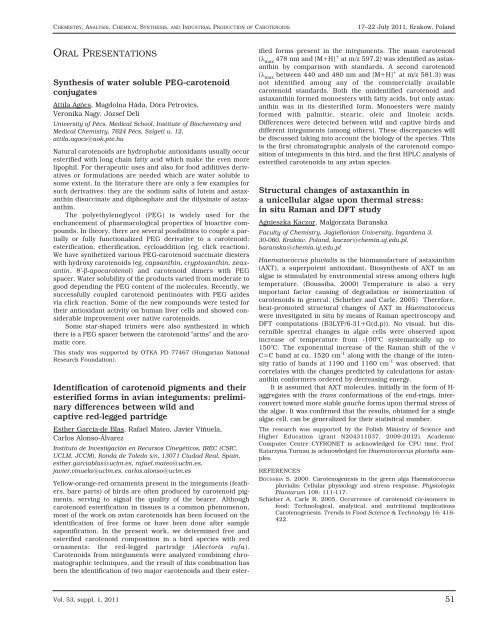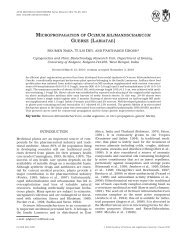ACTA BIOLOGICA CRACOVIENSIA
ACTA BIOLOGICA CRACOVIENSIA
ACTA BIOLOGICA CRACOVIENSIA
You also want an ePaper? Increase the reach of your titles
YUMPU automatically turns print PDFs into web optimized ePapers that Google loves.
CHEMISTRY, ANALYSIS, CHEMICAL SYNTHESIS, AND INDUSTRIAL PRODUCTION OF CAROTENOIDS<br />
ORAL PRESENTATIONS<br />
Synthesis of water soluble PEG-carotenoid<br />
conjugates<br />
Attila Agócs, Magdolna Háda, Dóra Petrovics,<br />
Veronika Nagy, József Deli<br />
University of Pécs, Medical School, Institute of Biochemistry and<br />
Medical Chemistry, 7624 Pécs, Szigeti u. 12,<br />
attila.agocs@aok.pte.hu<br />
Natural carotenoids are hydrophobic antioxidants usually occur<br />
esterified with long chain fatty acid which make the even more<br />
lipophil. For therapeutic uses and also for food additives derivatives<br />
or formulations are needed which are water soluble to<br />
some extent. In the literature there are only a few examples for<br />
such derivatives: they are the sodium salts of lutein and astaxanthin<br />
disuccinate and diphosphate and the dilysinate of astaxanthin.<br />
The polyethyleneglycol (PEG) is widely used for the<br />
enchancement of pharmacological properties of bioactive compounds.<br />
In theory, there are several posibilities to couple a partially<br />
or fully functionalized PEG derivative to a carotenoid:<br />
esterification, etherification, cycloaddition (eg. click reaction).<br />
We have synthetized various PEG-carotenoid succinate diesters<br />
with hydroxy carotenoids (eg. capsanthin, cryptoxanthin, zeaxantin,<br />
8'-β-apocarotenol) and carotenoid dimers with PEG<br />
spacer. Water solubility of the products varied from moderate to<br />
good depending the PEG content of the molecules. Recently, we<br />
successfully coupled carotenoid pentinoates with PEG azides<br />
via click reaction. Some of the new compounds were tested for<br />
their antioxidant activity on human liver cells and showed considerable<br />
improvement over native carotenoids.<br />
Some star-shaped trimers were also synthesized in which<br />
there is a PEG spacer between the carotenoid "arms" and the aromatic<br />
core.<br />
This study was supported by OTKA PD 77467 (Hungarian National<br />
Research Foundation).<br />
Identification of carotenoid pigments and their<br />
esterified forms in avian integuments: preliminary<br />
differences between wild and<br />
captive red-legged partridge<br />
Esther García-de Blas, Rafael Mateo, Javier Vińuela,<br />
Carlos Alonso-Álvarez<br />
Instituto de Investigación en Recursos Cinegéticos, IREC (CSIC,<br />
UCLM, JCCM), Ronda de Toledo s/n, 13071 Ciudad Real, Spain,<br />
esther.garciablas@uclm.es, rafael.mateo@uclm.es,<br />
javier.vinuela@uclm.es, carlos.alonso@uclm.es<br />
Yellow-orange-red ornaments present in the integuments (feathers,<br />
bare parts) of birds are often produced by carotenoid pigments,<br />
serving to signal the quality of the bearer. Although<br />
carotenoid esterification in tissues is a common phenomenon,<br />
most of the work on avian carotenoids has been focused on the<br />
identification of free forms or have been done after sample<br />
saponification. In the present work, we determined free and<br />
esterified carotenoid composition in a bird species with red<br />
ornaments: the red-legged partridge (Alectoris rufa).<br />
Carotenoids from integuments were analyzed combining chromatographic<br />
techniques, and the result of this combination has<br />
been the identification of two major carotenoids and their ester-<br />
Vol. 53, suppl. 1, 2011<br />
17–22 July 2011, Krakow, Poland<br />
ified forms present in the integuments. The main carotenoid<br />
(λ max 478 nm and [M+H] + at m/z 597.2) was identified as astaxanthin<br />
by comparison with standards. A second carotenoid<br />
(λ max between 440 and 480 nm and [M+H] + at m/z 581.3) was<br />
not identified among any of the commercially available<br />
carotenoid standards. Both the unidentified carotenoid and<br />
astaxanthin formed monoesters with fatty acids, but only astaxanthin<br />
was in its diesterified form. Monoesters were mainly<br />
formed with palmitic, stearic, oleic and linoleic acids.<br />
Differences were detected between wild and captive birds and<br />
different integuments (among others). These discrepancies will<br />
be discussed taking into account the biology of the species. This<br />
is the first chromatographic analysis of the carotenoid composition<br />
of integuments in this bird, and the first HPLC analysis of<br />
esterified carotenoids in any avian species.<br />
Structural changes of astaxanthin in<br />
a unicellular algae upon thermal stress:<br />
in situ Raman and DFT study<br />
Agnieszka Kaczor, Malgorzata Baranska<br />
Faculty of Chemistry, Jagiellonian University, Ingardena 3,<br />
30-060, Kraków, Poland, kaczor@chemia.uj.edu.pl,<br />
baranska@chemia.uj.edu.pl<br />
Haematococcus pluvialis is the biomanufacture of astaxanthin<br />
(AXT), a superpotent antioxidant. Biosynthesis of AXT in an<br />
algae is stimulated by environmental stress among others high<br />
temperature. (Boussiba, 2000) Temperature is also a very<br />
important factor causing of degradation or isomerization of<br />
carotenoids in general. (Schieber and Carle, 2005) Therefore,<br />
heat-promoted structural changes of AXT in Haematococcus<br />
were investigated in situ by means of Raman spectroscopy and<br />
DFT computations (B3LYP/6-31+G(d,p)). No visual, but discernible<br />
spectral changes in algae cells were observed upon<br />
increase of temperature from -100°C systematically up to<br />
150°C. The exponential increase of the Raman shift of the ν<br />
C=C band at ca. 1520 cm-1 along with the change of the intensity<br />
ratio of bands at 1190 and 1160 cm-1 was observed, that<br />
correlates with the changes predicted by calculations for astaxanthin<br />
conformers ordered by decreasing energy.<br />
It is assumed that AXT molecules, initially in the form of Haggregates<br />
with the trans conformations of the end-rings, interconvert<br />
toward more stable gauche forms upon thermal stress of<br />
the algae. It was confirmed that the results, obtained for a single<br />
algae cell, can be generalized for their statistical number.<br />
The research was supported by the Polish Ministry of Science and<br />
Higher Education (grant N204311037, 2009-2012). Academic<br />
Computer Centre CYFRONET is acknowledged for CPU time. Prof.<br />
Katarzyna Turnau is acknowledged for Haematococcus pluvialis samples.<br />
REFERENCES<br />
BOUSSIBA S. 2000. Carotenogenesis in the green alga Haematococcus<br />
pluvialis: Cellular physiology and stress response. Physiologia<br />
Plantarum 108: 111-117.<br />
Schieber A, Carle R. 2005. Occurrence of carotenoid cis-isomers in<br />
food: Technological, analytical, and nutritional implications<br />
Carotenogenesis. Trends in Food Science & Technology 16: 416-<br />
422.<br />
51












